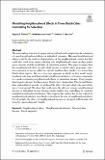Files in this item
Modelling neighbourhood effects in three Dutch cities controlling for selection
Item metadata
| dc.contributor.author | Troost, Agata A. | |
| dc.contributor.author | van Ham, Maarten | |
| dc.contributor.author | Janssen, Heleen J. | |
| dc.date.accessioned | 2021-08-25T13:30:01Z | |
| dc.date.available | 2021-08-25T13:30:01Z | |
| dc.date.issued | 2021-08-24 | |
| dc.identifier | 275067691 | |
| dc.identifier | 8496ac24-90d0-430b-958d-06b6dafe2d12 | |
| dc.identifier | 85113384669 | |
| dc.identifier | 000687953800001 | |
| dc.identifier.citation | Troost , A A , van Ham , M & Janssen , H J 2021 , ' Modelling neighbourhood effects in three Dutch cities controlling for selection ' , Applied Spatial Analysis and Policy , vol. First Online . https://doi.org/10.1007/s12061-021-09411-5 | en |
| dc.identifier.issn | 1874-463X | |
| dc.identifier.other | ORCID: /0000-0002-2106-0702/work/99115916 | |
| dc.identifier.uri | https://hdl.handle.net/10023/23836 | |
| dc.description | The research leading to these results has received funding from the European Research Council under the European Union's Seventh Framework Programme (FP/2007–2013)/ERC Grant Agreement n. 615159 (ERC Consolidator Grant DEPRIVEDHOODS, Socio-spatial inequality, deprived neighbourhoods, and neighbourhood effects), as well as from European Union's Horizon 2020 research and innovation programme under Grant Agreement n. 727097 (RELOCAL). | en |
| dc.description.abstract | The non-random selection of people into neighbourhoods complicates the estimation of causal neighbourhood effects on individual outcomes. Measured neighbourhood effects could be the result of characteristics of the neighbourhood context, but they could also result from people selecting into neighbourhoods based on their preferences, income, and the availability of alternative housing. This paper examines how the neighbourhood effect on individual income is altered when geographic selection correction terms are added as controls, and how these results vary across three Dutch urban regions. We use a two-step approach in which we first model neighbourhood selection, and then include neighbourhood choice correction components in a model estimating neighbourhood effects on individual income. Using longitudinal register datasets for three major Dutch cities: Amsterdam, Utrecht and Rotterdam, and multilevel models, we analysed the effects for individuals who moved during a 5-year period. We show that in all cities, the effect of average neighbourhood income on individual income becomes much smaller after controlling for explicitly modelled neighbourhood selection. This suggests that studies that do not control for neighbourhood selection most likely overestimate the size of neighbourhood effects. For all models, the effects of neighbourhood income are strongest in Rotterdam, followed by Amsterdam and Utrecht. | |
| dc.format.extent | 28 | |
| dc.format.extent | 770947 | |
| dc.language.iso | eng | |
| dc.relation.ispartof | Applied Spatial Analysis and Policy | en |
| dc.subject | Neighbourhood effects | en |
| dc.subject | Neighbourhood selection | en |
| dc.subject | Selection bias | en |
| dc.subject | Income | en |
| dc.subject | Social inequality | en |
| dc.subject | GF Human ecology. Anthropogeography | en |
| dc.subject | E-DAS | en |
| dc.subject | SDG 11 - Sustainable Cities and Communities | en |
| dc.subject.lcc | GF | en |
| dc.title | Modelling neighbourhood effects in three Dutch cities controlling for selection | en |
| dc.type | Journal article | en |
| dc.contributor.sponsor | European Research Council | en |
| dc.contributor.institution | University of St Andrews. Population and Health Research | en |
| dc.contributor.institution | University of St Andrews. School of Geography & Sustainable Development | en |
| dc.identifier.doi | https://doi.org/10.1007/s12061-021-09411-5 | |
| dc.description.status | Peer reviewed | en |
| dc.date.embargoedUntil | 2021-08-24 | |
| dc.identifier.grantnumber | ERC-2013-CoG | en |
This item appears in the following Collection(s)
Items in the St Andrews Research Repository are protected by copyright, with all rights reserved, unless otherwise indicated.

